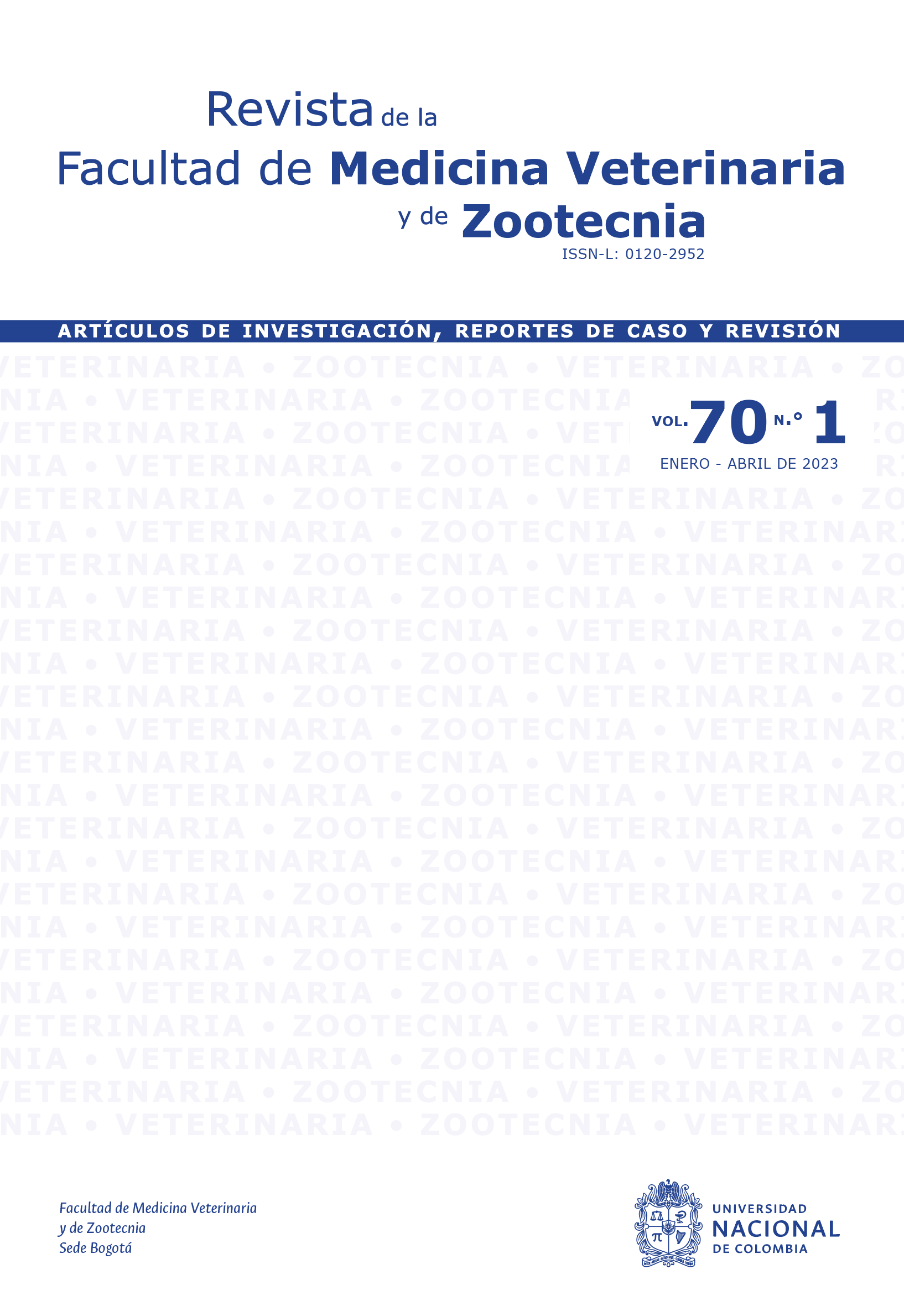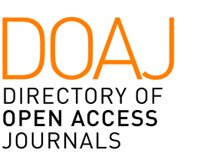Impacto ecológico del insecticida fipronil: valoración de riesgos en humanos
Ecological impact of fipronil insecticide: risk assessment in humans
DOI:
https://doi.org/10.15446/rfmvz.v70n1.100631Palabras clave:
aves, Colombia, fipronil, invertebrados terrestres, mamíferos, pesticida (es)fipronil, Colombia, pesticide, terrestrial invertebrates, mammals, birds (en)
Descargas
El fipronil es uno de los pesticidas más importantes usados en agricultura y animales domésticos. A concentraciones muy bajas para el control de especies destino, también es tóxico para especies no destino, incluyendo a las abejas y numerosos macroinvertebrados acuáticos y terrestres. Estudios de laboratorio y campo han demostrado que tanto el fipronil, como sus productos de degradación, a concentraciones medioambientales observadas son suficientes para poner en peligro numerosos taxones de la comunidad acuática, incluidos los peces. En esta revisión se describen estudios de ecotoxicología cuyo impacto en especies no destino ha sido clave para que la Unión Europea prohibiese el fipronil para uso agrícola en 2013 y Estados Unidos lo haya restringido en muchos cultivos y actualmente lo esté revisando para renovar los distintos registros. En Colombia se siguen registrando al menos 60 productos a base de fipronil y desde agosto de 2021 se prohíbe su uso en plantaciones de aguacate, café, cítricos y pasifloras. En 2017, a raíz de la contaminación de huevos con fipronil en Europa, la Agencia Europea para la Seguridad de Alimentos publicó varios estudios sobre el riesgo para la salud humana que podía tener el consumo de huevos y carne de pollos con residuos de fipronil. La conclusión fue que la ingesta de fipronil a las concentraciones detectadas en huevos y carne no superaba niveles esperados que produjesen efectos adversos para la salud.
Fipronil is one of the most important pesticides used in agriculture and domestic animals. At very low concentrations used for controlling target species, it is also toxic to non-target species including bees and numerous aquatic and terrestrial macroinvertebrates. Laboratory and field studies have shown that both fipronil, and its degradation products, at relevant environmental concentrations are sufficient to endanger numerous taxa in the aquatic community, including fish. In this review, ecotoxicology studies are described that show significant impact on non-target species that have been instrumental to ban fipronil for agriculture in the European Union since 2013 and restricting many uses in the United States. In Colombia, at least 60 fipronil-based products continue to be registered and since August 2021 its use has been prohibited in avocado, coffee, citrus and ornamental flower plantations. In 2017, following the widespread contamination of eggs with fipronil across Europe, the European Food Safety Authority (EFSA) conducted several risk assessments for the consumption of eggs and chicken meat contaminated with fipronil residues. The conclusion was that the consumption of fipronil at the concentrations detected in eggs and meat did not exceed levels expected to pose health hazard for humans.
Referencias
Al–Badran AA, Fujiwara M, Gatlin DM y Mora MA. 2018. Lethal and sub-lethal effects of the insecticide fipronil on juvenile brown shrimp Farfantepenaeus aztecus. Scientific Reports. 8(1):10769. https://doi.org/10.1038/s41598-018-29104-3 DOI: https://doi.org/10.1038/s41598-018-29104-3
Ali A, Nayar JK y Gu WD. 1998. Toxicity of a phenyl pyrazole insecticide, fipronil, to mosquito and chironomid midge larvae in the laboratory. Journal of the American Mosquito Control Association. 14(2):216-218.
Balança G y De Visscher M. 1997. Impacts on nontarget insects of a new insecticide compound used against the desert locust [Schistocerca gregaria (Forskål 1775)]. Archives of Environmental Contamination and Toxicology. 32(1):58-62. https://doi.org/10.1007/s002449900155 DOI: https://doi.org/10.1007/s002449900155
Birckel P, Cochet P, Benard P y Weil A. 1998. Cutaneous distribution of 14C-fipronil in the dog and in the cat following a spot-on administration. Butterworth-Heinemann Ltd. Disponible en: https://scholar.google.com/scholar_lookup?title=Cutaneous+distribution+of+14C-fipronil+in+the+dog+and+in+the+cat+following+a+spot-on+administration&author=Birckel%2C+P.&publication_year=1998
Boletín Oficial del Estado. 2013. Real Decreto 630/2013, de 2 de agosto, por el que se regula el Catálogo español de especies exóticas invasoras. Ministerio de Agricultura, Alimentación y Medio Ambiente. BOE-A-2013-8565. Disponible en: https://www.boe.es/eli/es/rd/2013/08/02/630
Cheng T. 1995. Dermal absorption of 14C-fipronil REGENT 80WDG in male rats (preliminary and definitive phases). In Unpublished report No. HWI 6224-210 from Hazleton Wisconsin, Inc. (Research Triangle Park, NC, USA, Submitted to WHO by Rhone-Poulenc, Inc.).
Commission Implementing Regulation. 2013. (EU) No. 781/2013 amending Implementing Regulation (EU) No. 540/2011, as regards the conditions of approval of the active substance fipronil, and prohibiting the use and sale of seeds treated with plant protection products containing this active substance. Official Journal of the European Union. L 219:22-25.
Elzen GW. 2001. Lethal and sublethal effects of insecticide residues on Orius insidiosus (Hemiptera: Anthocoridae) and Geocoris punctipes (Hemiptera: Lygaeidae). Journal of Economic Entomology. 94(1):55-59. https://doi.org/10.1603/0022-0493-94.1.55 DOI: https://doi.org/10.1603/0022-0493-94.1.55
Eshra ES, El–Shahaat M y Dewer Y. 2016. Molluscicidal Potential of Two Neonicotinoids and Fipronil Against Three Terrestrial Snail Species. International Journal of Zoological Investigations. 2:1-8.
Federal Agency for the Safety of the Food Chain (FASFC). 2017. Risk assessment and risk management with regard to the presence of fipronil in eggs, egg products, poultry meat, and processed products. Nota del 23 de agosto de 2017.
Flores F, Kaserzon S, Elisei G, Ricardo G y Negri AP. 2020. Toxicity thresholds of three insecticides and two fungicides to larvae of the coral Acropora tenuis. PeerJ, 8, e9615. https://doi.org/10.7717/peerj.9615 DOI: https://doi.org/10.7717/peerj.9615
French Agency for Food, Environmental and Occupational Health & Safety (ANSES). 2017. The maximum concentration of fipronil not to be exceeded in egg products and other processed products containing eggs, to ensure that consumer exposure remains below the acute toxicological reference value. ANSES scientific and technical support. Request No 2017-SA-0183.
German Federal Institute for Risk Assessment (BfR).2017a. Fipronil in foods containing eggs: Estimations of maximum tolerable daily consumption. No 019/2017 of August 2017. Disponible en: https://www.bfr.bund.de/cm/349/fipronil-in-foods-containing-eggs-estimations-of-maximum-tolerable-daily-consumption.pdf.
German Federal Institute for Risk Assessment (BfR). 2017b. Health assessment of fipronil levels in chicken meat in Germany based on the first analysis results for pullets and laying hens from the few affected businesses in Germany. No. 020/2017 of August 2017. Disponbile en: https://mobil.bfr.bund.de/cm/349/health-assessment-of-fipronil-levels-in-chicken-meat-in-germany-based-on-the-first-analysis-results.pdf
German Federal Institute for Risk Assessment (BfR). 2018a. Updated assessment of the health risks posed by longer-term consumption of foods containing fipronil. No. 002/2018 of January 2018. Disponible en: https://www.anses.fr/en/system/files/ERCA2017SA0183EN.pdf
German Federal Institute for Risk Assessment (BfR). 2018b. Updated assessment of the health risks posed by longer-term consumption of foods containing fipronil. No. 002/2018 of January 2018. Disponible en: https://mobil.bfr.bund.de/cm/349/updated-assessment-of-the-health-risks-posed-by-longer-term-consumption-of-foods-containing-fipronil.pdf
Gunasekara AS, Truong T, Goh KS, Spurlock F y Tjeerdema RS. 2007. Environmental fate and toxicology of fipronil. Journal of Pesticide Science. 32(3):189-199. https://doi.org/10.1584/jpestics.R07-02 DOI: https://doi.org/10.1584/jpestics.R07-02
Holder P, Jones A, Tyler C y Cresswell J. 2018. Fipronil pesticide as a suspect in historical mass mortalities of honey bees. Proceedings of the National Academy of Sciences. https://doi.org/10.1073/pnas.1804934115 DOI: https://doi.org/10.1073/pnas.1804934115
Holmes P. 1991. M&B 46030: Toxicity study by oral (capsule) administration to Beagle dogs for 52 weeks. In Unpublished report No. 92/RHA31o/0842 from Life Science Research Ltd. (Research Triangle Park, NC, USA, Submitted to WHO by Rhone-Poulenc, Inc. 1991.
Instituto Colombiano Agropecuario (ICA). 2021.Resolución N.° 092101 “Por medio de la cual se suspende temporalmente el registro de los productos formulados que contengan como ingrediente activo fipronil y que dentro de los usos aprobados estén los cultivos de aguacate, café, cítricos y/o pasifloras. 2 de marzo de 2021.
Ismail BS, Nuraziah A, Nor-Aini D, Maimon A. 2004. Effect of repeated applications of fipronil on arthropod populations in experimental plot studies. Pertanika Journal of Tropical Agriculture Science (Malaysia). 27(2):135-142. http://agris.upm.edu.my:8080/dspace/handle/0/9706
Jackson D, Cornell CB, Luukinen B, Buhl K, Stone D. 2009. Fipronil Technical Fact Sheet [Internet]. National Pesticide Information Center. 2009 [citado 25 de noviembre de 2021]. Disponible en: http://npic.orst.edu/factsheets/archive/fiptech.html
Kandil MA, Fouad EA, El Hefny DE y Abdel–Mobdy YE. 2020. Toxicity of Fipronil and Emamectin Benzoate and Their Mixtures Against Cotton Leafworm, Spodoptera littoralis (Lepidoptera: Noctuidae) With Relation to GABA Content. Journal of Economic Entomology. 113(1):385-389. https://doi.org/10.1093/jee/toz232 DOI: https://doi.org/10.1093/jee/toz232
Lee SJ, Mulay P, Diebolt-Brown B, Lackovic MJ, Mehler LN, Beckman J, Waltz J, Prado JB, Mitchell YA, Higgins SA, Schwartz A y Calvert GM. 2010. Acute illnesses associated with exposure to fipronil—Surveillance data from 11 states in the United States, 2001-2007. Clinical Toxicology (Philadelphia, Pa.), 48(7):737-744. https://doi.org/10.3109/15563650.2010.507548 DOI: https://doi.org/10.3109/15563650.2010.507548
Mize SV, Porter SD y Demcheck DK. 2008. Influence of fipronil compounds and rice-cultivation land-use intensity on macroinvertebrate communities in streams of southwestern Louisiana, USA. Environmental Pollution. 152(2):491-503. https://doi.org/10.1016/j.envpol.2007.03.021 DOI: https://doi.org/10.1016/j.envpol.2007.03.021
NMFS. 2021. Fisheries N. Office of Science and Technology | NOAA Fisheries [Internet]. NOAA. 2021 [citado 26 de noviembre de 2021]. Disponible en: https://www.fisheries.noaa.gov/about/office-science-and-technology
Peveling R, McWilliam AN, Nagel P, Rasolomanana H, Raholijaona Rakotomianina L, Ravoninjatovo A, Dewhurst CF, Gibson G, Rafanomezana S y Tingle CCD. 2003. Impact of locust control on harvester termites and endemic vertebrate predators in Madagascar. Journal of Applied Ecology. 40(4):729-741. https://doi.org/10.1046/j.1365-2664.2003.00833.x DOI: https://doi.org/10.1046/j.1365-2664.2003.00833.x
Scott JG y Wen Z. 1997. Toxicity of Fipronil to Susceptible and Resistant Strains of German Cockroaches (Dictyoptera: Blattellidae) and House Flies (Diptera: Muscidae). Journal of Economic Entomology. 90(5):1152-1156. https://doi.org/10.1093/jee/90.5.1152 DOI: https://doi.org/10.1093/jee/90.5.1152
Tingle CCD, Rother JA, Dewhurst CF, Lauer S y King WJ. 2003. Fipronil: Environmental fate, ecotoxicology, and human health concerns. Reviews of Environmental Contamination and Toxicology. 176:1-66. https://doi.org/10.1007/978-1-4899-7283-5_1 DOI: https://doi.org/10.1007/978-1-4899-7283-5_1
U.S. Environmental Protection Agency (USEPA).1996. New Pesticide Fact Sheet - Fipronil; EPA 737-F-96-005; U.S. Environmental Protection Agency, Office of Prevention, Pesticides and Toxic Substances.1996 Office of Pesticide Programs, U.S. Government Printing Office Washington, DC.; pp 1-10. Disponible en: https://nepis.epa.gov/Exe/ZyPURL.cgi?Dockey=P1001KCY.TXT
US Environmental Protection Agency (USEPA). 1999. Memorandum: EFED´s section 3 Registration Eligibility Decision Chapter for fipronil use on rice as a pre-plant broadcast treatment. Office of Prevention Pesticides and Toxic Substance, Washington DC. Disponible en: https://archive.epa.gov/pesticides/chemicalsearch/chemical/foia/web/pdf/129121/129121-123.pdf
US Environmental Protection Agency (USEPA). Fipronil: Third Reevaluation - Report of the Hazard Identification Assessment Review Committee; HED Doc. No. 014400. Disponible en: https://www3.epa.gov/pesticides/chem_search/cleared_reviews/csr_PC-129121_18-Apr-07_a.pdf
US Environmental Protection Agency (USEPA). 2000. Health Effects Division, U.S. Government Printing Office 2000: Washington DC, pp. 1-24. Disponible en: https://www.cdc.gov/nchs/data/hp2000/hp2k01.pdf
U.S. Environmental Protection Agency (USEPA). 2004. Overview of the Ecological Risk Assessment Process in the Office of Pesticide Programs. Office of Prevention, Pesticides, and Toxic Substances. Office of Pesticide Programs. Washington DC. Disponible en: https://www.epa.gov/sites/default/files/2014-11/documents/ecorisk-overview.pdf
U.S. Environmental Protection Agency (USEPA). 2007. Updated Section 18, Ecological Risk Assessment for fipronil Use to Control Cabbage Maggot in Turnip and Rutabaga. 2007; Environmental Protection Agency, Washington, D.C. Disponible en: https://archive.epa.gov/pesticides/chemicalsearch/chemical/foia/web/pdf/129121/129121-2007-04-18a.pdf
U.S. Environmental Protection Agency (USEPA). 2016. Review of Toxicity Studies with fipronil Degradates (Fipronil Sulfone, Fipronil Sulfide, and Fipronil Desulfinyl).2016; Office of Chemical Ssafety and Pollution Prevention. Washington, D. C. Disponible en: https://www.regulations.gov/docket/EPA-HQ-OPP-2011-0448/document
US Environmental Protection Agency (USEPA). 2020. Fipronil: acute and chronic aggregate dietary exposure for the registration review of fipronil. Office of Chemical Safety and Pollution Prevention. Disponible en: https://downloads.regulations.gov/EPA-HQ-OPP-2011-0448-0075/content.pdf
US Environmental Protection Agency (USEPA). United States Environmental Protection Agency. 2012 Ecological Risk Assessment. http://www.epa.gov/oppefed1/ecorisk_ders/toera_analysis_eco.htm. Accessed Nov 2021.
US Geological Survey (USGS). 2003. Fipronil and Degradation Products in the Rice-Producing Areas of the Mermentau River Basin, Louisiana, February- September 2003; USGS Fact Sheet FS-010-0; U.S. Department of the Interior, US Geological Survey. Disponible en: https://pubs.er.usgs.gov/publication/fs01003 (accessed Nov 2021).
Weston DP y Lydy MJ. 2014. Toxicity of the Insecticide Fipronil and Its Degradates to Benthic Macroinvertebrates of Urban Streams. Environmental Science & Technology. 48(2):1290-1297. https://doi.org/10.1021/es4045874 DOI: https://doi.org/10.1021/es4045874
Zaluski R, Kadri SM, Alonso DP, Martins Ribolla PE y De Oliveira Orsi,R. 2015. Fipronil promotes motor and behavioral changes in honey bees (Apis mellifera) and affects the development of colonies exposed to sublethal doses. Environmental Toxicology and Chemistry. 34(5):1062-1069. https://doi.org/10.1002/etc.2889 DOI: https://doi.org/10.1002/etc.2889
Zazycki LCF, Semedo RES, Silva A, Bisognin AZ, Bernardi O, García MS y Nava DE. 2015. Biology and fertility life table of Eriopis connexa, Harmonia axyridis and Olla v-nigrum (Coleoptera: Coccinellidae). Brazilian Journal of Biology. 75:969-973. https://doi.org/10.1590/1519-6984.03814 DOI: https://doi.org/10.1590/1519-6984.03814
Zhang L, Yang J, Li H, You J, Chatterjee N y Zhang X. 2020. Development of the transcriptome for a sediment ecotoxicological model species, Chironomus dilutus. Chemosphere, 244:125541. https://doi.org/10.1016/j.chemosphere.2019.125541 DOI: https://doi.org/10.1016/j.chemosphere.2019.125541
Zhao X, Yeh JZ, Salgado VL y Narahashi T. 2004. Fipronil is a potent open-channel blocker of glutamate-activated chloride channels in cockroach neurons. The Journal of Pharmacology and Experimental Therapeutics. 310(1):192-201. https://doi.org/10.1124/jpet.104.065516 DOI: https://doi.org/10.1124/jpet.104.065516
Cómo citar
APA
ACM
ACS
ABNT
Chicago
Harvard
IEEE
MLA
Turabian
Vancouver
Descargar cita
Licencia
Derechos de autor 2023 Revista de la Facultad de Medicina Veterinaria y de Zootecnia

Esta obra está bajo una licencia internacional Creative Commons Atribución-NoComercial-SinDerivadas 4.0.
Aquellos autores/as que tengan publicaciones con esta revista, aceptan los términos siguientes:
a) Los autores/as conservarán sus derechos de autor y de publicación y garantizarán a la revista el derecho de primera publicación de su obra, el cuál estará simultáneamente sujeto a la Licencia de reconocimiento de Creative Commons que permite a terceros compartir la obra siempre que se indique su autor y su primera publicación esta revista.
b) Los autores/as podrán adoptar otros acuerdos de licencia no exclusiva de distribución de la versión de la obra publicada (p. ej.: depositarla en un archivo telemático institucional o publicarla en un volumen monográfico) siempre que se indique la publicación inicial en esta revista.
c) Se permite y recomienda a los autores/as difundir su obra a través de Internet (p. ej.: en archivos telemáticos institucionales o en su página web) antes y durante el proceso de envío, lo cual puede producir intercambios interesantes y aumentar las citas de la obra publicada. (Véase El efecto del acceso abierto).
d) Las tablas y figuras que no indiquen en su parte inferior la fuente de la información se consideran resultados del estudio que está siendo publicado, es decir, que fueron elaborados por los autores del manuscrito basados en la información obtenida y procesada en la investigación, reporte de caso, etc que está siendo publicado.
AUTORIZACIÓN DE PUBLICACIÓN Y ACUERDO EDITORIAL
Una vez sometidos los manuscritos, los autores/as confieren a la dirección editorial de la Revista de la Facultad de Medicina Veterinaria y de Zootecnia en su versión impresa (ISSN 0120-2952) y en su versión online (ISNN 2357-3813) autorización para su publicación de acuerdo con los siguientes criterios:
a) Somos los autores/as intelectuales del manuscrito, que éste es inédito, es decir, que no ha sido remitido, aceptado o publicado en otras revistas o publicaciones técnico-científicas impresas ni electrónicas y aceptamos que sea publicado en la Revista de la Facultad de Medicina Veterinaria y de Zootecnia en caso de ser aprobado.
b) El contenido total o parcial del manuscrito remitido no será sometido para su publicación en otra(s) revista(s) durante la duración de los procesos de evaluación por pares y edición de la Revista de la Facultad de Medicina Veterinaria y de Zootecnia.
c) Todos los autores/as han leído la versión definitiva del artículo presentado y se hacen responsables por todos los conceptos e información de texto e imágenes allí contenidos ante la Universidad Nacional de Colombia y ante terceros. La dirección editorial de la Revista no se hace responsable por la veracidad y autenticidad de dicha información, ni será responsable de dirimir conflictos relacionados con la autoría del manuscrito.
d) El artículo sometido a consideración del Comité Editorial de la Revista de la Facultad de Medicina Veterinaria y de Zootecnia cumple las normas establecidas en la política de publicación y las instrucciones a los autores. En caso contrario el manuscrito será rechazado hasta no haber acogido la totalidad de la normativa de presentación de manuscritos.
e) Los autores/as se dan por informados que el proceso de arbitraje y edición del artículo puede tomar varios meses y que su recepción no implica ni la aprobación ni la publicación del mismo.
f) Una vez terminado el proceso de evaluación los autores/as se comprometen a atender y consolidar, estrictamente en los plazos de tiempo establecidos por el editor, todas las observaciones, correcciones o sugerencias hechas por los pares evaluadores del artículo y por el editor. Durante el proceso de corrección de estilo y edición, se verificará la consolidación de las observaciones de los evaluadores, razón por la cual, en caso de encontrar que no han sido integradas al documento, éste no será publicado hasta que sus autores no las consoliden; sin embargo, en caso de que alguna(s) de las correcciones formuladas por los pares evaluadores no puedan ser adicionadas a la versión definitiva del artículo, los autores podrán sustentar sus razones al editor de la revista en el oficio de remisión del artículo definitivo.
g) La totalidad de los autores/as aprueba la publicación del documento completo en sus versiones impresa y digital, lo que incluye las diferentes bases de datos en los que la Revista es y será incluida para promover su visibilidad.
h) Los autores/as conocen que la autorización incluye la posibilidad para la Revista de comercializar la publicación a través de los canales tradicionales y de Internet, o cualquier otro medio conocido, y aceptan que la autorización de publicación se hace a título gratuito, por lo tanto renuncian a recibir remuneración alguna por la publicación, distribución, comunicación pública y cualquier otro uso que se haga en los términos en que la obra es publicada.
i) La Revista se compromete a indicar siempre la autoría de sus contenidos incluyendo el nombre de los autores/as y la fecha de publicación. De igual forma, los autores/as se comprometen a citar los trabajos publicados en esta publicación de acuerdo con los estándares internacionales de citación, incluyendo el nombre completo o abreviado de la Revista (Rev Med Vet Zoot.).

























